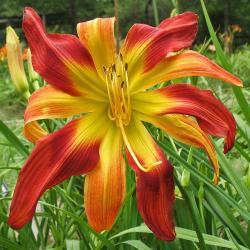Does AHS know that there are major differences between polymerous daylilies and doubles? Let me explain why I even have to ask this ridiculous question. The botanical term "polymerous" refers to flowers that are syntepalous, i.e., those that have four or more segments in the petal and sepal whorls that are joined at the base, forming the perianth tube in daylilies.
It is commonly perceived that the two basic types of doubles are petaloid and layered types. The petaloid types form "false petals", referred to as petaloids, which is just petal type material growing along the stamens. These petaloids are not true segments of additional petal or sepal. Actually, these petaloid doubles are really single blooms with the outgrowth of material on the stamens giving the appearance of a double daylily. I see these petaloid types as singles with fluffy stuff in the middle.
The layered doubles are completely different. Here, you actually have the addition of another whorl of petals/sepals, and the whorls are stacked upon themselves. Therein lies the major difference between doubles and polymerous daylilies. In polymerous daylilies extra true segments are added to the existing petal and sepal whirls and joined at the base, forming the perianth tube. In layered doubles the additional petals/sepals are formed in a new separate whorl and stacked upon the existing whorls. The petaloid doubles are single blooms with petal-type growth on the stamens.
Amazingly, AHS groups polymerous daylilies with doubles for the purpose of exhibitions. If you consider each major characteristic that I just described regarding polymerous daylilies, layered doubles, and petaloid doubles then how can the leading scientific and educational authority on Hemerocallis group these together in the same category for exhibition purposes?
It does not stop there, though. AHS has a completely different position regarding polymerous daylilies when it comes to classifying them for the purpose of registration. Here, the AHS has gotten it right because daylily registration is based up the scientific and botanically correct definition.
Whenever I raise these issues within AHS I am countered with "there are not enough registered polys to just their own category." Well, the distinction between polymerous daylilies and all other daylilies is "enough" to warrant a unique category for the purpose of registration, regardless of numbers, based on scientific and botanical characteristics. However, rather establishing a separate exhibition category for polymerous daylilies based on botanical and scientific characteristics AHS tosses them in the doubles creating greater confusion and going against the scientific and educational mission of the Society. If there are not enough registered polymerous daylilies to "justify" a unique exhibition category for them, then do the right thing and don't let them be exhibited. This would be better than misclassifying them and misrepresenting them as doubles. In fact, based upon the unique characteristic of polymerous daylilies, they more similar botanically and scientifically to all the various single form daylilies than they are to the double form. AHS made the right call for Registration purposes but totally blew it for Exhibitions when it comes to polymerous daylilies.
It is not a matter of numbers, rather, it is a matter of doing the right thing.

